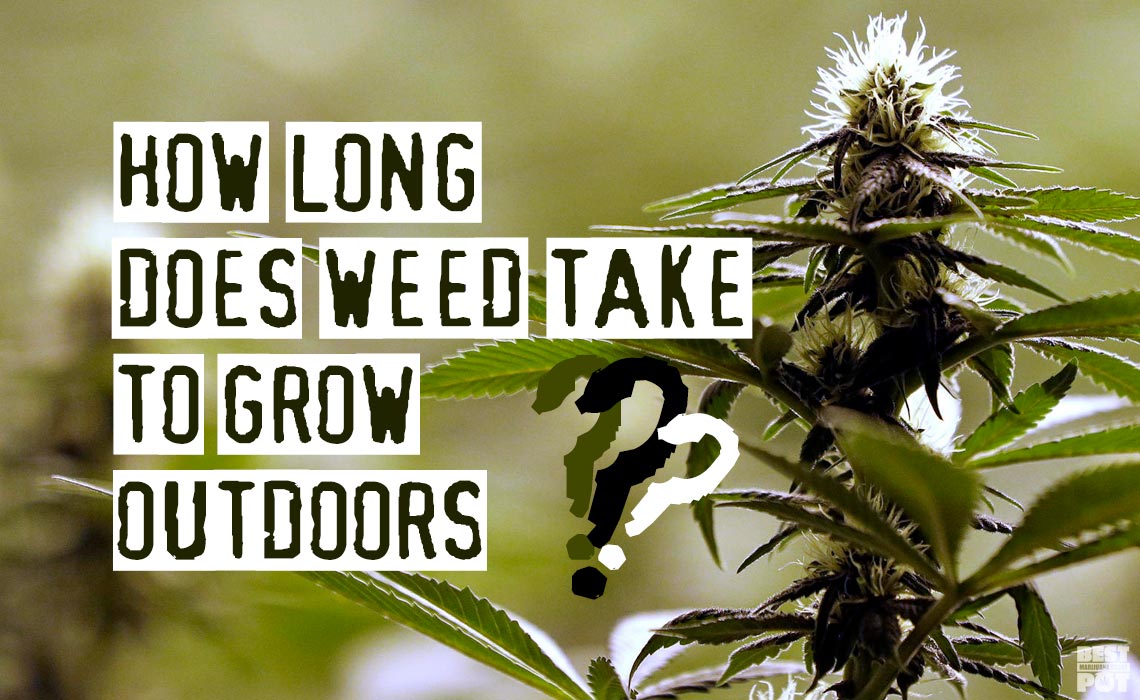The amount of time it takes to grow cannabis outdoors is dependent on several factors, including the climate, seed variety/strain, planting season, and site preparation. Nevertheless, the average amount of time for cannabis to be fully matured is between 7 to 16 weeks, and this period is influenced by two major phases, which include the vegetative and flowering phases. Other essential attributes that influence the growth and maturity of weed include its variety (indica or sativa), and if the strains are photoperiod or autoflowering. The light cycles and the amount of time that these plants are exposed to light tend to influence their maturity period. Cannabis plants have traditionally been grown in natural environments, but those who lack a garden can use different sizes of containers to grow weed. Furthermore, the discovery of autoflowering strains such as cannabis ruderalis which are less dependent on exposure to light for them to start flowering implies that buds can be harvested within 7 to 12 weeks.
Climate
Time is considered as one of the most important factors for outdoor growing of weed. After planting the most appropriate variety of seeds, germination will require enough moisture and warmth. The average temperature should be between 24 and 28 degree Celsius (75-82 F), which is higher than the average room temperature. It is at this point where the difference between growing weed in the garden or in an outdoor pot becomes prominent, but an individual should allow the seeds to grow in sowing soil. This implies that a small pot can be filled with moist soil and the seeds are then placed approximately half a centimeter below the soil’s surface. The pot or container is then covered using a translucent plastic or a cling film and is then placed in a relatively warm area. Germination will begin between 3 and 7 days and this will mainly depend on the variety/strain of seed that was planted and the level of temperature.
After the first leaves are visible above the ground, the next important step is to ensure that the seedlings are exposed to adequate light. Light and sufficient moisture enables the plant to remain compact, where the internodes are able to germinate close to each other without stretching and falling, thus leading to stronger plants. Temperatures that are below 400F can cause serious damage to different varieties of weed. Therefore, planting during late spring or early frost requires an individual to use cold frames, hot caps, or other protective measures to enhance effective germination. In addition, strong winds can damage trichomes, break branches, or stress the growing plants, thus increasing their vulnerability to diseases and pest attacks. Therefore a windbreak can be erected when the garden is exposed to high winds.
Although cannabis needs moisture to germinate, excess water and rainfall can seriously damage the plants, leading to stunted growth and rotting of the roots. It is important to note that weed does not grow well in environments that are constantly wet. When the seedlings are still young, watering should be done at moderate intervals which continue to increase as the plants become bigger. Excessive rainfall is regarded as a nuisance to the germination of cannabis since they lead to mildew and mold issues, particularly during the flowering period. Therefore, when cannabis is grown in an open garden, temporary shelter can be built when expecting heavy rainfall. Lastly, cannabis germinates well in soils that contain the right mixture of nutrients. Therefore, during their life cycle, nutrients can be maintained by using organic fertilizers that contain nitrogen, potassium, and phosphorus. The way in which these nutrients are provided depends on the nature of soil composition and the methods that are used to grow the plants.
Outdoor Strains
Outdoor strains of cannabis tend to differ, and since most of the varieties of weeds germinate in a natural way, it is important to select the most appropriate strain depending on the environmental conditions of where they are planted. Cannabis strains can be classified as either hybrid or pure variety, and the purpose of each variety is to make it more potent, effective, or distinguishable from other varieties. Furthermore, although certain strains have become resistant to rainy climates and mould, evidence indicates outdoor seeds need abundant sunshine and adequate warmth. It is also important to note that timing is essential when planting different strains of cannabis, taking into consideration that they can germinate to huge proportions when exposed to best environmental conditions.
A common outdoor strain of cannabis is Biddy Early and it is a variety of Magus Genetics. After its full cycle of growth, it reaches a height of 1.8 to 2 meters and this is the reason why it is referred to as the classical Sativa Xmass tree. Furthermore, its flowering stage up to maturation promotes its cultivation in open fields. However, the vegetative stage can take extended time, especially when grown under low temperatures and light. The second strain is the Big Bud and it is considered as the greatest producer of seed stocks. Its potency and productive capacity make this cannabis to be bred for XL blooms where there are steady high levels of THC. This variety is recommended for growers who are experienced and who can push the limits of its genetics, regulate its exposure to humidity, and who can prevent the presence of mould.
The third strain is the Blue Power and it is considered as highly pleasurable and a pretty form of hybrid cannabis. When germinated under favorable conditions, this strain provides generous yields that contain robust and dense Indica posture. Apart from its cute bluish flowers, this variety produces a smooth smoke that has a unique aroma and fruity flavor. Furthermore, it tastes like blueberry and this is associated with its blueberry legacy. This strain has a powerful effect in uplifting moods and reducing stress, anxiety, migraines and other mental problems. Early Skunk is another feminized strain of cannabis that performs well in outdoor environments. It is also regarded as an all-round strain when it comes to the collection of Sensi Seed Bank due to its rapid rate of germination. In addition, it is vibrant and has the ability of producing heavy harvests and frosted bud in different kinds of climate.
Another important strain that is popular for its relaxing effect and medicinal attributes is known as the Big Bang. This variety of cannabis is a hybrid and a feminized crossbreed of other strains such as Northern Light, Skunk, and El Nino. Bubba Kush is another feminized strain of cannabis that grows to huge heights and intensive physical dimensions. Its Humboldt seeds are considered as a dominant strain of indica. Furthermore, this variety produces a sweet aroma that is prevalent among all indica varieties. This strain is also popular for producing a strong relaxation which is typical for indica varieties. Furthermore, this strain has a short stature, short internodes, a powerful sweet taste, as well as wide leaves. Furthermore, this breed produces a narcotic effect that has the ability of relaxing a person after a hard day at work.
Harvest and Use
Basically, it can be argued that after the flowering process of cannabis that take an average of seven to nine months, most strains that are grown outdoors will be almost ready for harvesting. One of the techniques of determining if cannabis has reached its harvesting stage is to examine the small glistening balls that are known as trichomes and they are located in the buds. When the buds begin to form the amber color, it implies that their flowering period is almost complete and they are almost ready for harvesting. In addition, when cannabis is harvested after the trichomes appear as milky white, or half translucent and half milky, an individual can attain the greatest level of THC which provides the ‘high’ effect. If only half the trichomes are coloured in amber, the level of THC that will be attained will slightly less, but they will contain a higher CBD that is good in offering the ‘stoned’ effect and relaxation. Therefore, it is important to examine the signs that offer the best times of harvesting of weed in order to prevent degradation of quality. It is also important to examine the range of time that takes weed to mature in order to get the best quality.


